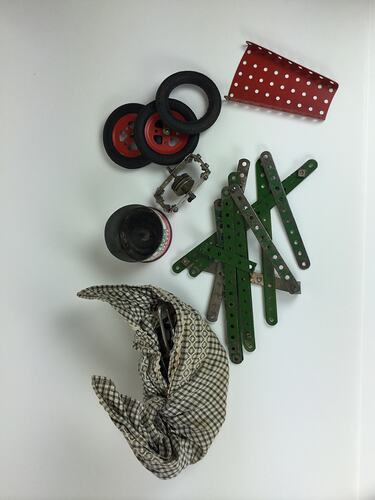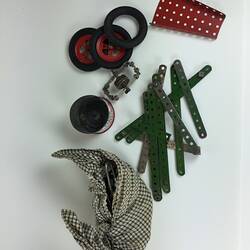Designed and produced by George Irving from 1931, Ezy-Bilt toys were cars, boats, cranes and buildings made from metal plates that connected with a fastening mechanism of interlocking pins. The design was patented by Australian inventor James Perrott in 1922 (1) in order to be simple for small children to use without the tools needed for nuts and bolts. The Ezy-Bilt system was so similar in design and use to the well-known Meccano, with its modularity and heavy-duty metal construction, that Ezy-Bilt was sued by Meccano for copyright infringement, the case being settled confidentially. (2)
Ezy-Bilt toys were widely considered to be good value. Early Ezy-Bilt set contained 88 components that could make up 25 different models. Later expansions boasted instructions for up to 255 models from instructions released across a series of booklets. (3) A Pocket Edition of the construction set contained just 44 parts, intended to be taken on trips and holidays. Ezy-Bilt toys would go on to be produced under numerous owners in Australia and under licence New Zealand. While the history of Ezy-Bilt in Australia is well- documented, the record of its production in New Zealand is more obscure.
The Ezy-Bilt company was first listed in 1936 in the Melbourne telephone directory at 318 Flinders Lane. (4) Throughout the 1930s Ezy-Bilt sets were manufactured across several factories in Fitzroy and Melbourne, Victoria. Ezy-Bilt would expand their toy line over time, adding rubber wheels made by Melbourne rubber manufacturing firm Barnet Glass, and clockwork motors made by Rytime Robilt, another Melbourne-based company that manufactured commercial motors and model trains.
Ezy-Bilt toys ceased to be manufactured in Melbourne in 1941, along with much of the Australian toy industry, under orders of the Department of War Organization of Industry. Materials were required for the war effort with Japan entering World War II at this time. Concern over the quality and safety of backyard production toys would pressure the government to release the constraints, and by 1944 permits were issued for toy manufacture, albeit to a high-quality standard and sold at a controlled price.
George Irving continued making toys after the war from a small factory in Caulfield, Victoria under different brand names and licenses. He did not return to Ezy-Bilt, the name now being used by an Adelaide firm, Colton Palmer and Preston, with Ezy-Bilt toys being back on shelves for Christmas of 1944. Following World War II, Ezy-Bilt sets appeared in use by the Australian Army in the teaching of bridge-building techniques for Army engineers, due to their robust construction and simple modular design.
The Ezy-Bilt name made its way through a number of different manufacturers from the end of World War II onwards, initially under the ownership of Colton Palmer and Preston in 1954, moving again in 1955 and once more in 1960, managed by an Irving-era Ezy-Bilt factory manager. The Ezy-Bilt company was then bought and sold a number of times during the 1960s, with the last known advertisements for Ezy-Bilt appearing in 1968.
Ezy-Bilt is notable for having survived numerous rapid shifts in ownership and management with very little change to the product design itself. The Ezy-Bilt name officially came to an end under the ownership of Dickson Primer Ltd, with the Ezy-Bilt company listed for liquidation in 1984.
References
Department of Patents, Commonwealth of Australia. (1922). 1922007007: An improved fastening element for use in building constructional toys and models. http://pericles.ipaustralia.gov.au/ols/auspat/applicationDetails.do?applicationNo=1922007007
Luke Jones. (2019). Ezy-Bilt. Australian Toys: A Collection. Melbourne Books. Pp. 270-271.
Ezy Bilt: The Master Toy. (1957). Advertisement. https://www.meccanoindex.co.uk/Other/Ezy-Bilt/Ezy-Bilt-2-Ad.pdf
The Argus. (5 March 1937). New Companies. Finance, Commerce, Mining. P. 6. URL: https://trove.nla.gov.au/newspaper/article/11047204
More Information
-
Keywords
-
Localities
-
Authors
-
Article types

